Table of contents
Peanuts ( Arachis hypogaea ) contain a lot of fat and therefore have a high calorie content. They are rarely available raw, organic quality is preferable.
Use in the kitchen
Can you eat peanuts raw? It is possible to eat peanuts raw. However, in addition to phytic acid, 11 which binds minerals, they also contain lectins.27 Raw (dried) peanuts have a slightly sweet, earthy-nutty taste, reminiscent of peas. Roasted, they taste more intense and are also less susceptible to mold and the formation of aflatoxin, which is carcinogenic.
Raw peanuts (with skin) are suitable as a snack, for making peanut butter, sauces, homemade bars or for enriching muesli, e.g. in gluten-free pea muesli (or pea muesli plus oat flakes ). Most peanuts that you can buy are heated. Even peanuts with the shell on are usually roasted and therefore no longer raw. Roasted, shelled peanuts are often found in stores (plain, salted or sugared).
The legumes are also suitable for cakes, biscuits or other baked goods. They are a popular ingredient in Asian wok dishes, soups, curries and salads. The food industry uses peanuts in some sweets, but they are mainly used as the main ingredient in peanut butter and peanut oil . However, since you should only eat a few peanuts a day, you can mix them with other nuts. Macadamia nuts and almonds have a similar consistency. With walnuts, pecans, pistachios, hazelnuts ,pumpkin seeds, linseed and hemp seeds, you can quickly put together a nut mix to suit your needs.
Can you eat peanuts unpeeled? It is possible to eat the thin brownish skin of the peanuts. Not everyone finds the texture and taste pleasant and easy to digest. The papery skin of the peanut is rich in antioxidants and phytochemicals, so eating it with the shell is nutritionally beneficial. 11
Vegan recipe for tofu and bean wok with peanuts
Ingredients for 2 people: 100 g (cooked) kidney beans, 100 g soba noodles, 1 tbsp sesame oil, 200 g tofu, 200 g green beans, 3 tbsp soy sauce, 1 tbsp coriander, 3 tbsp peanuts, 1 tbsp turmeric .
Preparation: Cook the soba noodles according to the instructions on the packet until they are soft. Wash the green beans, remove the stalks and cook in water for about 10 minutes. Heat the oil and fry the tofu until golden brown on the outside. Fry the crunchy green beans and kidney beans for a few minutes. Add the soy sauce and 50 ml of water and simmer for about 10 minutes. Fold the cooked noodles, peanuts and coriander into the tofu and bean mixture and serve.
Vegan recipes with peanuts can be found under the note: " Recipes that have the most of this ingredient ".
| Not only vegans or vegetarians should read this: Vegans often eat unhealthily. Avoidable nutritional errors . |
Purchasing - Storage
Peanuts (in the shell) can be found in the DA-CH countries in late autumn and winter at major retailers and supermarkets such as Coop, Migros, Denner, Volg, Spar, Aldi, Lidl, Rewe, Edeka, Billa and Hofer etc. Shelled, roasted and salted peanuts are available all year round .
In organic quality or raw, peanuts are more likely to be found in health food stores, organic shops, drugstores, organic supermarkets such as Denn's Biomarkt and Alnatura, or online. In raw quality and without the shell, you can also get so-called wild peanuts (Kacang Lurik, lurik peanuts, or Arachis hypogaea L. var. lurikensis ) from Indonesia, whose skin looks patterned or striped. 28
The term "raw" for peanuts advertised as raw food often refers only to the omission of a roasting process. After harvesting, the peanuts are dried; the producers do not always take the temperature restrictions (e.g. 42 °C for "real" raw food) seriously. In addition, with nuts in general - although peanuts are not nuts - it is common practice in the industry to heat the unshelled kernels (to 150 °C) so that the shell can be removed more easily. 12,13 The term "raw food" is not protected by law - unlike organic. If you only want to eat raw food quality, it is worth doing a germ test to check the quality.
Blanched peanuts without the seed skin can be found in stores, as can blanched almonds or hazelnuts . Blanching increases the shelf life and makes it easier to remove the brown skin. The term blanched nuts generally refers to light-colored specimens without the seed skin (by briefly boiling in water, by so-called "dry blanching" usually using hot air). 14 However, the term is not clear. "Blanching" can also refer to processes to facilitate the peeling process (cracking), as is used for unshelled Brazil nuts (in which case it is often a treatment with steam). 12,15
The availability of peanuts varies depending on the size of the store, catchment area, etc. Our recorded food prices for the DA-CH countries can be found above under the ingredient image - and by clicking on them you can see their development at different suppliers.
Storage tips
How should you store peanuts? Peanuts should be stored in a cool, dry place, protected from light. A thin cotton bag that allows air circulation is ideal, but it is important that they remain dry so that no mold forms. The ideal storage temperature is between 8 and 10 °C. Shelled peanuts can be stored either in the pantry or in the refrigerator in a tightly sealed container.
How long can you store peanuts? Unpeeled peanuts that are airtight can be stored for several months. Opened peanuts (shelled or unshelled) should be consumed within a few weeks. Peanuts that are stored open for too long are no longer crispy and can taste rancid.
Can you freeze peanuts? Shelled peanuts can be frozen and will last for up to a year.
Ingredients - Nutritional values - Calories
The energy content of peanuts is quite high at 567 kcal/100g. The calories come mainly from fat (49 g/100g) - of which 6.3 g/100g are saturated fats - and protein (26 g/100g). The carbohydrate content of 16 g/100g is moderate, with 4.7 g being sugar. Thefiber (8.5 g/100g) covers 34% of the daily requirement. 2
Peanuts contain a lot of folate (folic acid) at 240 µg/100g. Sunflower seeds have a similar folate content (227 µg/100g). This value is comparable to that of other pulses, such as white beans (388 µg/100g), kidney beans (394 µg/100g), broad beans (423 µg/100g) and chickpeas (557 µg/100g). Raw mung beans have a significantly higher content (625 µg/100g). 2 Since folate is one of the heat-sensitive vitamins and is lost even when heated slightly, the actual amount of folate (folic acid) is lower after preparation than when raw.
Of the eight essential amino acids, tryptophan is most commonly found in peanuts at 0.25 g/100g (101% of the daily requirement). Comparable values are found in dulse (0.53 g/100g), shelled hemp seeds (0.61 g/100g) and goa beans (0.76 g/100g). Dried porcini mushrooms have a higher content at 1.5 g/100g. The amino acid threonine is also abundant: 100 g contain 0.88 g, which corresponds to around 95% of the daily requirement. Brewer's yeast (2.7 g/100g) and spirulina (3 g/100g) have higher values. 2
Peanuts contain 1.9 mg/100g manganese . Sesame seeds (2.5 mg/100g), pecans (4.5 mg/100g) and hazelnuts (6.2 mg/100g) have higher manganese contents. 2 Manganese is important for healthy cartilage tissue. With a balanced diet that also contains nuts and seeds, the requirement is perfectly met.
The complete ingredients of peanuts, the coverage of the daily requirement and comparison values with other ingredients can be found in our nutrient tables. In the article Nutrients explained you will get a detailed insight into the topic.
Effects on health
Are peanuts healthy or unhealthy? Uncritical consumption of peanuts is problematic. Peanuts are not a superfood, but fat bombs.
In 2003, the EEK was commissioned by the Federal Office of Public Health ( FOPH ) to adapt the health significance of fats and oils, which was recorded in 1992, to the latest scientific findings. We have described this in more detail for the ingredient olive oil . Here are just the most important things: polyunsaturated fatty acids are essential and are divided into two main groups (there are others): linoleic acid and its derivatives as the group of omega-6 fatty acids (LA) and alpha-linolenic acid (ALA) (omega-3) and its derivatives. The main sources of pro-inflammatory LA are vegetable oils, 3 but also nuts and seeds. The main sources of healthy, anti-inflammatory omega-3 (ALA) are, for example, rapeseed oil, linseed, walnuts and green leafy vegetables. 3
Peanuts have a poor LA-ALA ratio: They contain practically no omega-3 fatty acids ( alpha-linolenic acid ), but a lot of omega-6 fatty acids ( linoleic acid ). Peanuts have around 16 g LA and only 0.1 g ALA per 100 g. This corresponds to a ratio of 160:1 instead of the 5:1 recommended by the Federal Office of Public Health . 2
Consuming large amounts of omega-6 fatty acids can increase the risk of blood clots (thrombosis) and inflammation. Therefore, it is beneficial to reduce the ratio of omega-6 to omega-3 fatty acids to 5:1, as opposed to the most common ratio of around 10:1. Research suggests that approaching this ratio may help prevent cardiovascular disease and reduce inflammation. 3
Health-conscious people get polyunsaturated fatty acids from linseed, chia seeds, walnuts (tree nuts), macadamia, herbs and leafy vegetables because these foods have a particularly good LA:ALA ratio. You can find detailed tables for this in our ingredients, which can also be accessed from the recipe . The recipes also summarize this. For example, Erb-Müesli has the ideal composition in a ratio of 1:1 (LA to ALA).
Nevertheless, many websites show how healthy peanuts are supposed to be, because these sites either copy them uncritically or want to sell. For example, in its article Peanuts - Superfood for the blood vessels (updated March 7, 2024) , the Center for Health presents a program that is intended to show that consuming peanuts in reasonable quantities does not contribute to weight gain. As part of the program, participants with high cholesterol ate 56 g of peanuts per day for four weeks. At the end of the study, they had lower total cholesterol levels and less LDL. If you read the FASEB study on this, Adding peanuts to a meal benefits vascular health, it quickly becomes clear how the result was achieved: The Peanut Institute "supported" it. What these 15 test subjects received as an alternative - one with harmful substances, one can assume - is not declared, at least in the abstract. There are studies that point to health benefits of eating peanuts in small quantities. 11 However, since many of the nutritional values of peanuts (per 100 g) cover more than half of the daily requirement and in some cases even exceed it, it is important to consume them in small quantities (1-2 spoons) and only occasionally.
Moreover, a randomized clinical trial and meta-analysis (2022) found that the overall protective effect of nut consumption on cardiovascular health is "inconclusive." Although some participants had lower cholesterol and LDL cholesterol:HDL cholesterol levels from peanut consumption, people at risk for cardiometabolic disease experienced weight gain with increased peanut consumption. 21 We can only warn: Vegans often eat unhealthily, as uninformed vegans often consume too many nuts and thus harm their health. See also this link about what happened with raw food (The Giessen Raw Food Study) .
Are raw or roasted peanuts healthier? Roasted peanuts have a higher fat content than raw peanuts. In the best case, raw peanuts are gently dried at low temperatures. Oil and heat improve the taste and consistency of roasted peanuts, but remove many of the natural nutrients and antioxidants contained in raw peanuts. Raw peanuts (gently dried) are healthier than roasted peanuts, even if they are more susceptible to mold. Roasting converts amino acids and reduced sugars in carbohydrate- or protein-rich foods into new compounds. However, this undesirable Maillard reaction leads to the formation of the carcinogenic substance acrylamide, which is formed from the amino acid asparagine. Even though roasted peanuts contain significantly less acrylamide than, for example, potato chips or peanut crisps, highly heated, roasted or toasted products should be avoided. 29
Secondary plant substances
Many of the health effects of peanuts can be attributed to the secondary plant substances they contain. Our article on secondary plant substances provides an overview of the classification of substance groups, their occurrence in foods and possible effects on humans. Peanuts contain the following secondary plant substances, among others: 11
- Isoprenoids : Triterpenes: Steroids (beta-sitosterol, campesterol and stigmasterol), saponins
- Polyphenols: Phenolic acids: Hydroxycinnamic acids (chlorogenic acid, caffeic acid, p-coumaric acid, ferulic acid); Flavonoids: Isoflavones (biochanin A, genistein); Stilbenes (resveratrol); Tannins
- Protease inhibitors: phytic acid
However, it should be noted that the composition of secondary plant substances in peanuts can vary depending on the variety, time of harvest and growing conditions. Therefore, quantities are only of limited use and should only be understood roughly.
Phytosterols in peanuts, such asbeta-sitosterol, campesterol and stigmasterol, block the absorption of cholesterol from food due to their cholesterol-like structure and inhibit inflammation and reduce the growth of some types of cancer. 11
The bioactive compounds contained in peanuts are known for their disease-preventing properties and are said to prolong life. The skin of the peanut seed in particular contains secondary metabolites. Reservatrol is also said to have effects against cancer, heart disease, degenerative nerve diseases, Alzheimer's and inflammation. 11
The antioxidant capacity in peanuts is due to compounds such as vitamin E in the oil as well as the phenolic acids chlorogenic acid, caffeic acid, p-coumaric acid, ferulic acid, flavonoids and the stilbene resveratrol. 11
Peanuts contain phytic acid, which reduces the bioavailability of other nutrients. However, the amount in peanuts is much lower than in soybeans, for example. 11
Dangers - Intolerances - Side effects
The proteins in the peanut kernel can trigger allergic reactions. There are very different, acute symptoms such as hives, watery eyes or breathing difficulties. Serious reactions that can even trigger anaphylactic shock are rarer. 5 Nevertheless, of all fatal food allergies, peanut allergy is the most common. 4
An allergic reaction can even occur through mere proximity or contact with the peanut. Cross-allergic reactions with lupins, tree nuts or birch pollen occur more frequently than reactions with similar proteins in other legumes, such as soy . The prevalence of the allergy is particularly notable in children in Western countries and usually lasts a lifetime, unlike other allergies that can be outgrown. 4 Another problem is the trypsin inhibitors (Ara h 2), which hinder protein metabolism in humans. During the heating process, this allergen is more pronounced in roasted than in boiled and fried peanuts. 4,12,26
Under poor storage conditions, the mold Aspergillus flavus can appear, which produces toxic aflatoxins. 6
Peanuts also contain lectins, which can have negative health effects in large quantities. After processing or heating (cooking or roasting for about 30 minutes), the protein in peanuts is no longer active. 27
According to EU regulations ( Allergen Labelling Directive 2003/89/EC ), all labels must contain a warning if these products contain peanuts or if contamination with peanuts is possible during production. 4
Ecological footprint - animal welfare
Peanuts sold in the UK have a carbon footprint of 1.47 kg CO 2 eq/kg (including production, transport and packaging). Shelled peanuts from Egypt have a value of 0.67 kg CO 2 eq/kg, although only agricultural production is taken into account here. 20 Unfortunately, there is no indication as to whether the peanuts are roasted or raw. The Danish climate database Concito comes to 3.12 kg CO 2 eq/kg for peanuts roasted in oil and salted. 19 This clearly shows how much food processing can make a difference.
Vegetables, one of the most climate-friendly foods, have a carbon footprint of around 0.1-0.5 kg CO 2 eq/kg (excluding transport), depending on the cultivation method. 18 The average carbon footprint of plant-based foods is 0.66 kg CO 2 eq/kg, which is only 10.7% of the CO 2 emissions of animal products (6.15 kg CO 2 eq/kg). 17 To keep the carbon footprint small, it is best to eliminate animal products from the menu.
The water footprint of peanuts (in shell) is 2782 l/kg in total. Tobacco and oil crops such as rapeseed have a comparable water footprint. The largest part of this is so-called 'green water'. 23 The green water footprint indicates the amount of rainwater used in production. The peanut is actually a crop that can survive with little water, as it is more sensitive to excessive irrigation. Water requirements are highest in the early growing season. In order to increase crop yields, farms increase the area under cultivation. 16 The cultivation of peanuts can therefore have a negative impact on land use.
Caution: conventional peanuts may be treated with toxic fungicides. Organic peanuts are produced without the use of synthetic pesticides, herbicides or fertilizers and are GMO-free. They must comply with organic farming regulations.
For detailed explanations of various sustainability indicators (such as ecological footprint, CO2 footprint, water footprint), see our article: What does the ecological footprint mean?
Animal welfare - species protection
Commercial peanuts are grown in monocultures. Monoculture plantations do not occur naturally and can be harmful to wild pollinators and the environment. Some animal species cannot move through the plantations to find food or shelter. In Australia, for example, some monocultures have resulted in the deterioration of bird, ground beetle, reptile and marsupial species. 25
The use of pesticides endangers the biological diversity of plants, soil organisms and aquatic organisms, among others. Possible countermeasures include organic production or improved risk assessment when approving pesticides. 30
Worldwide occurrence - cultivation
The home of the peanut is thought to be in the Andes. The oldest finds of peanuts in earlier human settlements come from Peru. In 2007, remains were found that were 7840 years old. 7 Today, peanuts are widespread as oil crops throughout the tropics and subtropics.
In 2022, according to the FAO ( Food and Agriculture Organization ) 54 million tons of peanuts are produced worldwide. 1 China, the largest producer, accounts for about 33% of world production with 18 million tons, but the country produces almost exclusively for its own consumption. 8 This is followed by India with 10 million tons and the USA with 2.5 million tons (in 2022). The main exporters of peanuts are the USA, Argentina, Sudan, Senegal and Brazil. The exports of these five countries together account for 71% of the total global export of peanuts. 22
Cultivation - Harvest
Peanut seeds germinate after a few days. However, the peanut plant needs a tropical to subtropical climate to grow. A warm room or greenhouse is sufficient for growing it yourself. Outside, a sunny, wind-protected balcony is ideal in midsummer. The peanut loves loose, sandy soil with a low peat content. At the beginning of growth, the plant needs a lot of water. Towards the end of the growth phase, you should keep the plant dry so that the fruit ripens well. 24 The annual plant reaches a height of 30 to 50 cm. After flowering, the lower part of the ovary lengthens to form a long, stalk-like fruit carrier and pushes the section with the ovule about 5 cm into the ground. This is where the peanut develops. As soon as the plants start to turn yellow, they must be pulled out of the ground and left to dry for about a week. After drying, the peanut seeds are removed. 24
In commercial production, peanut crops have an average growing period of 100 days. Irrigation intervals range from 6 to 14 days and can be as long as 21 days. During flowering, irrigation intervals are shorter. Irrigation on light-textured soils requires light and frequent water application. Flood irrigation is often used on medium-heavy soils. The yield with efficient water use in the cultivation of unshelled, dried nuts is 0.6 to 0.8 kg/m 3 . 16
The harvested crops are dried as quickly as possible to a water content of around 7%. In warm countries (India, China) the drying takes place outdoors for a few days. Only after this field drying are the nuts threshed, broken and in many cases shelled. There are various methods for removing the brownish-red skin: drying at around 140 °C and rubbing off the skin with a rubber roller or treatment with water (blanching): the kernels slide over a grid with sharp edges, sharp blades (spin) or rotating cylinders with abrasives (buff), then the kernels are dried. Or so-called "alkali blanching" in the treatment, the kernels are dipped in a lye solution for 8 seconds, which separates the skin from the kernel. 10
Further information
Why is the peanut not a nut? From a botanical point of view, peanuts ( Arachis hypogaea ) are legumes (Fabaceae or Leguminosae). They belong to the subfamily Faboideae, which also includes peas and beans.
The most popular types of peanuts are Runner, Virginia, Spanish and Valencia, which come in different sizes and shapes. The market also distinguishes between "long type" and "round type". 10
Arachis hypogaea L. var. lurikensis have more seeds (3-4) than ordinary peanuts, whose pods contain 2-3 seeds. 28
Alternative names:
Ashanthus nut, Arachis nut, Earth acorn, Earth pistachio, Cameroon nut, Spanish nut, Mesocarp nut. 9 The peanut is also known as Mundubi bean, Buren nut, Erdbohne, Java nut, Kuru nut, Mandubi nut and Tiger almond. In some Swiss cantons the peanut is known as Spanisches Nüssli.
The English names are peanut, goober, groundnut, ground-nut and monkey nut.
Other uses
The majority of peanut production is used to extract peanut oil. Peanuts are also used to make soap and paints. Other products include peanut butter and peanut crisps, cosmetics and an oil-based feed additive in agricultural animal fattening.
Bibliography - 30 Sources (Link to the evidence)
| 1. | FAO. FAOSTAT: Crops and livestock products. 2023. |
| 2. | USDA (United States Department of Agriculture). |
| 3. | Eidgenössische Ernährungskommission. Fette in der Ernährung. 2006. |
| 4. | The University of Manchester. Allergy information for: Peanut; ground nuts; monkey nuts (Arachis hypogea). 2006. |
| 5. | Sampson HA: Peanut Allergy. The New England Journal of Medicine. 2002;346:1294–1299. |
| 6. | Taber RA, Schroeder HW. Aflatoxin-producing potential of isolates of the Aspergillus flavus-oryzae group from peanuts (Arachis hypogaea). Appl Microbiol. 1967 Jan;15(1):140-144. |
| 7. | Dillehay TD, Rossen J, Andres TC, Williams DE. Preceramic adoption of peanut, squash, and cotton in northern Peru. Science. 2007 Jun 29;316(5833):1890-1893. |
| 8. | FAO. Land & Water. Crop information: Groundnuts, with shell. In: Produktionsstatistik der FAO für 2017. |
| 9. | Lieberei R, Reisdorff Ch, Franke W. Nutzpflanzen (8. Auflage). Stuttgart/ New York: Thieme; 2012. |
| 10. | Priestoph Import Argentur. Erdnüsse: Geschichte und Verarbeitung. |
| 11. | Arya SS, Salve AR, Chauhan S. Peanuts as functional food: a review. J Food Sci Technol. 2016 Jan;53(1):31-41. |
| 12. | Masthoff LJ, Hoff R et al. A systematic review of the effect of thermal processing on the allergenicity of tree nuts. Allergy. 2013;68(8):983–993. |
| 13. | Hokmabadi H, Sedaghati E. Safety of Food and Beverages: Nuts. In: Motarjemi Y (Ed.) Encyclopedia of Food Safety. 2014;3:340–348. |
| 14. | Google Patents: CA1108466A (Canada). Method of blanching nuts. |
| 15. | Google Patents: US1448431A (United States). Blanched brazil-nut kernel. |
| 16. | Food and Agriculture Organization of the United Nations. Land & Water. Groundnut. 2024. |
| 17. | Feng S, Lakshmanan P et al. A comprehensive continental-scale analysis of carbon footprint of food production: Comparing continents around the world. Journal of Cleaner Production. 2023;426:138939. |
| 18. | Pereira B de J, Cecílio Filho AB, La Scala N. Greenhouse gas emissions and carbon footprint of cucumber, tomato and lettuce production using two cropping systems. Journal of Cleaner Production. 2021;282:124517. |
| 19. | CONCITO. The big climate database. Version 1.1. Peanuts, oilroasted and salted. 2024. |
| 20. | Carboncloud. Schweden. Peanuts. 2024. |
| 21. | Parilli-Moser I, Hurtado-Barroso S et al. Effect of Peanut Consumption on Cardiovascular Risk Factors: A Randomized Clinical Trial and Meta-Analysis. Front Nutr. 2022 Apr 1;9:853378. |
| 22. | U.S. Customs and Border Protection. Peanuts and their classification under the Htsus. 2008. |
| 23. | Mekonnen MM, Hoekstra AY. The green, blue and grey water footprint of crops and derived crop products. Hydrol Earth Syst Sci. 2011;15(5):1577–1600. |
| 24. | National Peanut Board. 8 Simple Steps To Grow Your Own Peanuts At Home. 2023. |
| 25. | World Economic Forum. How single-crop farming is harming wildlife. 2015. |
| 26. | Maleki SJ, Viquez O et al. The major peanut allergen, Ara h 2, functions as a trypsin inhibitor, and roasting enhances this function. J Allergy Clin Immunol. 2003 Jul;112(1):190-195. |
| 27. | Ahmed EM. Lectin Quantitation in Peanut and Soybean Seeds. Peanut Science. 1986;13(7-10). |
| 28. | Rosyidi IN, Daryono BS. Phenotypic characters and genetic variations of lurik peanuts (Arachis hypogaea L. var. lurikensis) with Inter Simple Sequence Repeat. Biodiversitas. 2020;21(2). |
| 29. | Gesundheitsforschung - Gesundheitsschutz. Acrylamid und Human-Biomonitoring. Bundesgesundheitsbl. 2008. 51;98–108. |
| 30. | PAN Germany. Auswirkungen chemisch-synthetischer Pestizide auf die biologische Vielfalt. 2010. |

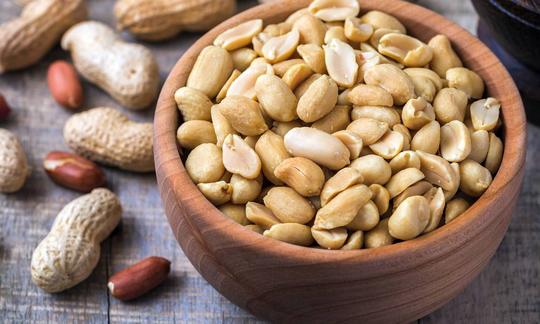

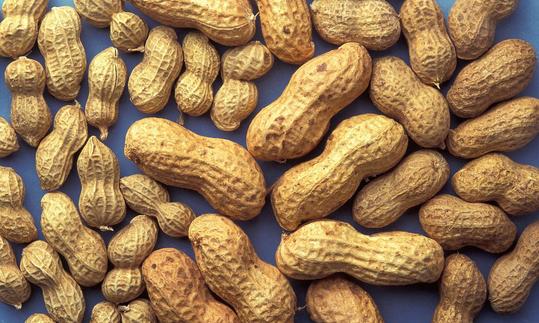

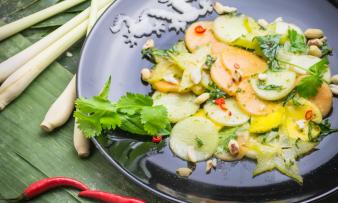
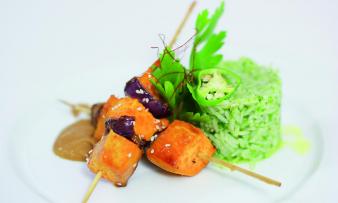
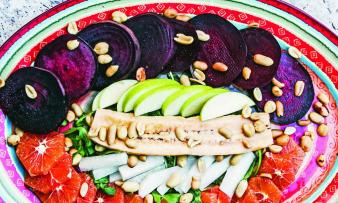





Comments